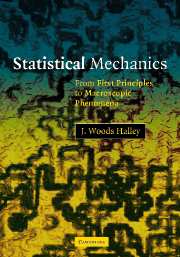Book contents
- Frontmatter
- Contents
- Preface
- Introduction
- Part I Foundations of equilibrium statistical mechanics
- Part II States of matter in equilibrium statistical physics
- Part III Dynamics
- 10 Hydrodynamics and definition of transport coefficients
- 11 Stochastic models and dynamical critical phenomena
- Appendix: Solutions to selected problems
- Index
10 - Hydrodynamics and definition of transport coefficients
Published online by Cambridge University Press: 05 June 2012
- Frontmatter
- Contents
- Preface
- Introduction
- Part I Foundations of equilibrium statistical mechanics
- Part II States of matter in equilibrium statistical physics
- Part III Dynamics
- 10 Hydrodynamics and definition of transport coefficients
- 11 Stochastic models and dynamical critical phenomena
- Appendix: Solutions to selected problems
- Index
Summary
General discussion
In general, by a hydrodynamic description of a many body fluid we mean a description valid at long wavelengths and low frequencies and which is based on closure of the local conservation laws of the fluid by use of a linear relation between fluxes and the gradients of densities. The coefficients of the linear relation are transport coefficients and they are phenomenological parameters of the hydrodynamic theory, calculable in principle from a theory describing the system at shorter length and time scales. The resulting hydrodynamic theory is generally a set of nonlinear partial differential equations of which the Navier–Stokes equations for the hydrodynamics of a simple fluid are a familiar example.
The reason that hydrodynamic theories accurately describe slow motions on large length scales is that global conservation laws link long distances to long times. Physically, for example, conservation of mass results in a diffusion equation in which the distance which particles diffuse increases with the square root of the time (see Problem 10.1). Although this link guarantees that some of the slow variables of the system are described by the hydrodynamic equations, it does not ensure that all of the slow variables can be so described. Near critical points associated with second order phase transitions, there are very slow changes in the fluid which are not described by the conservation laws of hydrodynamics, but which arise because of the very slow development and decay of large, almost stable regions looking like one of the (two or more) phases between which the system is slowly fluctuating.
- Type
- Chapter
- Information
- Statistical MechanicsFrom First Principles to Macroscopic Phenomena, pp. 195 - 216Publisher: Cambridge University PressPrint publication year: 2006



